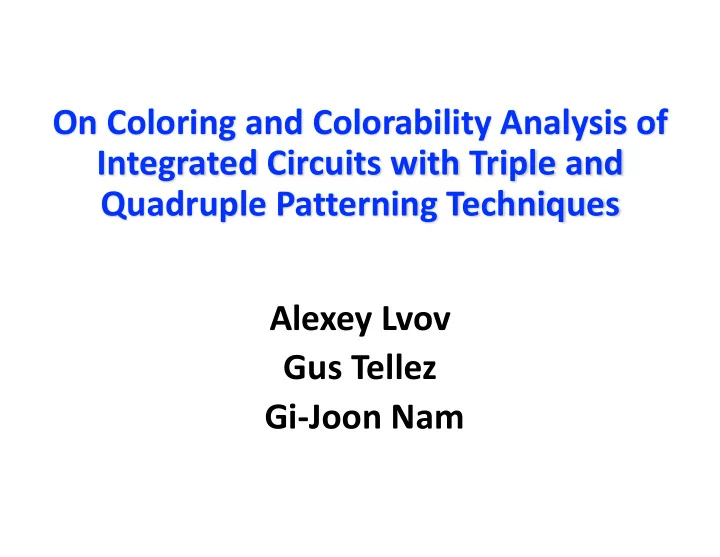

On Coloring and Colorability Analysis of Integrated Circuits with Triple and Quadruple Patterning Techniques Alexey Lvov Gus Tellez Gi-Joon Nam
Ba Backg ckground a and m motivation • Manaufacturing difficulty • 22nm: • Multi directional single patterned • 14nm: • Uni directional double patterning • 7nm: • Uni directional Self Aligned Double Patterning • Coloring decomposition & stitching • Mostly Post-fix heuristic methods • Lack of theoretical / constructive approaches 2
Bac ackground: Multi-patterning an and coloring pr probl blem • In Litho-Etch-Litho-Etch multi-patterning, shapes on one layer are assigned to a unique mask. • The layer is subdivided into k masks (k = 2, 3 or 4). • Two rules exist: 1. Two shapes that belong to one and the same mask must have a large minimum distance between them. 2. In order to legally place two shapes at a very small separation distance place them on two different masks. • Given a layout, the masks can be determined by solving a k- coloring problem on a constraint graph, where: The color represents a mask • Nodes represent shapes • Arcs occur when shapes are at a distance less than the SAME MASK • spacing rule This graph is called a “conflict graph” • 3
Layer coloring model & al algorithm Shapes Some of 7nm layers require FLAT 4-coloring occur at • Coloring CANNOT be done at a standard cell level critical • Coloring must be done post-placement distances across • Example of uncolored layer layout cell rows Shapes touch across cell rows 4
Fl Flat l layer 4 c er 4 col olori oring p pos ossibilities es Post-processing method • 4-coloring problem is NP-complete • But are the coloring instances we will see hard PD to color? Shapes layout • FLAT coloring means that coloring must be done: • During placement : run time prohibitive. • Post placement : can lead to slow manual fix up Coloring Engineering loop. change of order • How likely are placements that cannot be colored? No • No quantification method yet. Clean? • Our answer: • Correct-by-construction method: Build a layout model which set of design rules guarantees the colorability of a layout. Yes Design Rules Checking 5
La Layou out M Mod odel el • Blue rectangles are layout shapes. • Unit width shapes. • Shapes occur on a grid. • Conflict graph: • For every shape, there is a node in the graph. • There is an arc between nodes, when the corresponding shapes occur at or less than a minimum distance. 6
A mod A model is a a set of al all layouts that follow specified design rules together with a a definition of ad adjac acency of a a pai air of shap apes of a a layout. la t. 7
La Layou out m mod odel els & c & con onstructive c e col olor oring al algorithms with 4 colors • Model A • A layout model that shows most standard cell placements are easily colorable • Model B • A layout model incorporating the “cross-couple” with model A, where layouts are easily colorable • Models C and D • Layout models that shows that a small addition of flexibility in model A can lead to un-colorable layouts 8
Model A: Vertical al shap apes only. Dashed lines show adjacency. 9
Mo Mode del A: No Non-plan anar ar exam ample. E E = 55, 3 * V – 6 = 6 = 54. 54. Can not apply Four Color Map theorem. 10
Mo Mode del A: Coloring ng Algorithm. hm. 11
Mo Mode del B: Cross-link shapes are used in many standard cells. For example In XOR cell. 12
Mo Mode del B: Coloring ng Algorithm hm 13
14
NOT four colorab able models. Model C: Take model A and allow horizontal shapes of size 3-by-1. 15
Mo Mode del C C i is no s not 4 4-co colorable. Proof (1 of 3) 16
Mo Mode del C C i is no s not 4 4-co colorable. Proof (2 of 3) 17
Mo Mode del C C i is no s not 4 4-co colorable. Proof (3 of 3) 18
NOT four colorab able models. Model D: (A very slightly relaxed model B) 19
Mo Mode del C C i is no s not 4 4-co colorable. Proof (1 of 2) 20
Mo Mode del C C i is no s not 4 4-co colorable. Proof (2 of 2) 21
Three colorab ability. Model E. 22
Model E is not three colorab able. 23
Model F. Add more constrai aints: Still not three colorab able: 24
Model G: Add even more constrai aints. 25
Model G: Add even more constrai aints. No Now it is much harder to fi find a not colorable example. Bu But it exists. . The model in still NO NOT colorable. 26
The leftmost and the rightmost shapes In this configuration must have one and the same color : 27
An Any y further reduction of limits on the number of horizontal al or vertical al interac actions between shap apes lead ads to a a three-colorab able model. Mo Mode del H: 28
Conclusions an and Future Resear arch We analyzed triple and quadruple coloring of various layout • models, with the goal of developing robust layout methodologies. Layout models that guarantees 3/4-colorability are presented • • O(n*log(n)) time complexity for coloring, making them suitable for practical layouts • Demonstrated that a slight relaxation can lead to un-colorability For correct-by-construction layout, we would like to explore • further the correct-by-construction layout model • Analyzing further the complexity of triple and quadruple coloring of the graphs that result from layouts which belong to models that are not generally colorable but some individual layouts of which still can be colored. • Investigation on the standard-cell generation methodology using the generated models 29
Recommend
More recommend